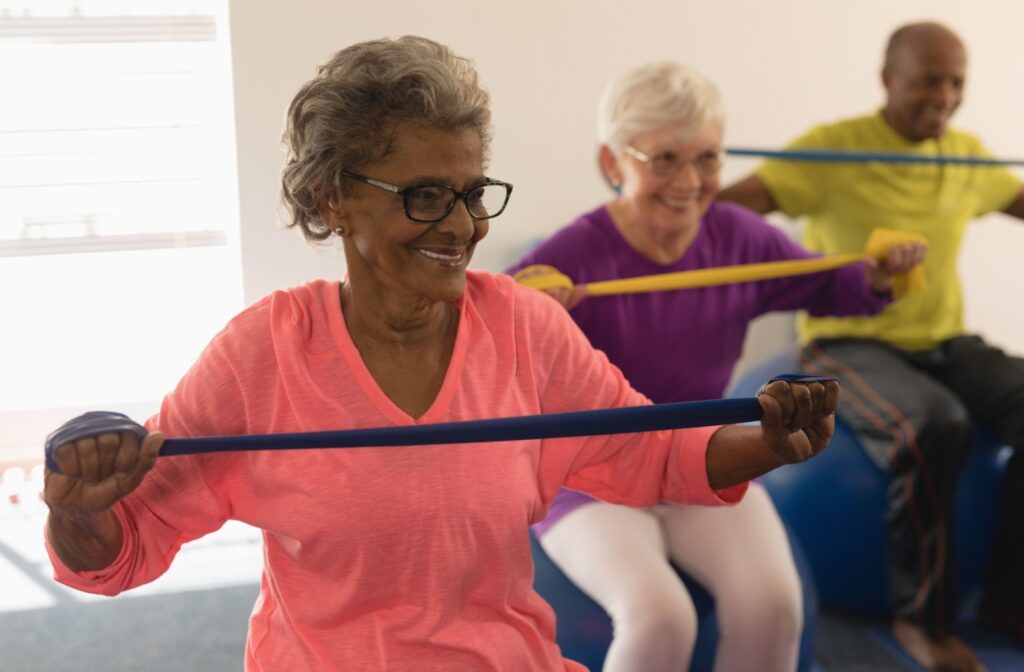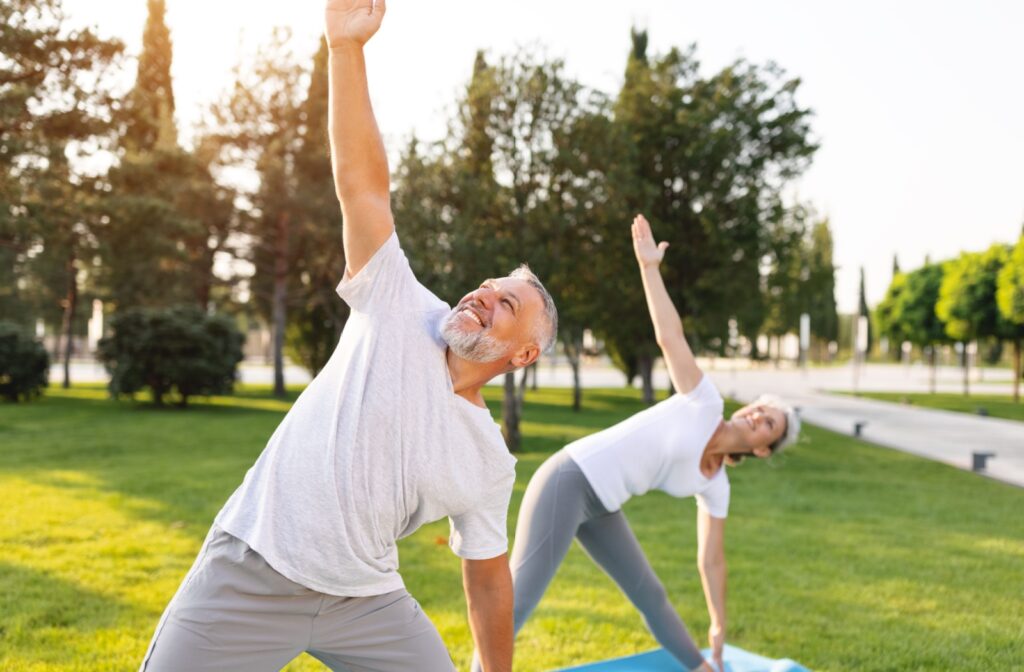Key Takeaways
- Most seniors benefit from about 150 minutes of moderate activity per week
- Personal fitness levels and health history affect how much exercise is safe
- Low-impact options like walking, water aerobics, and chair yoga are great for joint health
- Strength training can be done safely using resistance bands, bodyweight movements, or chair-based exercises
- Signs of overexertion include fatigue, soreness, or longer recovery time
- Creating a safe exercise routine means starting slow, mixing activities, and listening to your body
Senior-Friendly Exercise Advice
Staying active is one of the best ways to support your health as you age. However, knowing how much exercise is right—and how much might be too much—can feel like a balancing act. For many older adults, the goal is to maintain energy, independence, and wellness without overexertion or injury.
Most older adults should aim for about 150 minutes of moderate activity each week. However, your personal limits depend on your health, experience, and how your body responds. The important thing is safety at all times—make sure you’re prioritizing your own health.
Why Exercising Safely Is So Important for Seniors
Your body changes as you get older, and that includes how much physical activity you can handle. While staying active remains important for your health and wellness, finding the right balance becomes key to enjoying your retirement life safely. Your health history, lifestyle, and prior fitness habits all shape your tolerance.
If you’ve always enjoyed physical activity, your body may handle more intensity than someone who’s just starting out. So, listen to your body’s daily signals about energy levels and how you feel during activities. Some days you might feel ready for a longer walk, while other days a gentle stretching session might be more appropriate.
Finding the Right Activity Level for You
The CDC recommends at least 150 minutes of moderate-intensity activity per week for adults over 65. That’s about 30 minutes a day, five days a week. This doesn’t have to be an intense period in the gym—it could be as simple as trying:
- Brisk walks
- Water aerobics
- Light cycling
- Low-impact fitness classes
You can split these sessions into smaller chunks if that works better for your schedule. Three 10-minute walks throughout the day count just as much as one 30-minute session.
Higher-Impact Exercise Recommendations
If you prefer higher-intensity activities and your body can handle them, you can aim for 75 minutes of vigorous exercise weekly instead. This might include activities like hiking, jogging, or swimming laps. Add in muscle-strengthening exercises at least two days a week, and balance exercises three times weekly to reduce fall risk.
Gentle Exercises That Support Senior Wellness
Not all fitness routines require intensity. Low-impact exercises often offer full-body benefits without stressing joints or increasing fall risk. So, for older adults looking to try gentle exercises, it helps to try:
- Water aerobics. The water cushions joints while helping build strength and cardiovascular health.
- Walking. This is accessible, flexible, and adaptable to any pace. Walking paths in retirement communities make it easy to add movement to your day.
- Chair-based movement. From seated stretches to gentle marching, chair exercises support flexibility, circulation, and energy without requiring full weight-bearing.
Social engagement can also boost motivation. Walking with a friend or joining group fitness programs builds connection alongside physical strength.

Strength Training Without Heavy Weights
Muscle tone naturally decreases with age. This is entirely natural, but it can also be prevented. Older adults can still stay strong with the right exercises—it just involves being a little more careful. So, instead of lifting heavy weights, try:
- Resistance bands. Lightweight, portable, and adaptable to most fitness levels.
- Chair yoga. Great for flexibility and balance, especially when traditional yoga is challenging.
- Bodyweight movements. Simple options like wall push-ups or sit-to-stands can be done safely at home.
These options help build strength and confidence without requiring special equipment or risk.
How to Create a Senior-Safe Exercise Plan
A thoughtful approach makes all the difference. Even small changes to your routine can add up over time. To make your exercise routine safer and more sustainable, make sure you:
- Start slowly, especially if you’re new to regular movement
- Choose activities you enjoy so you’re more likely to stay consistent
- Build rest days into your weekly plan
- Mix up activities to support flexibility, strength, and heart health
- Track how you feel before and after exercise to spot helpful patterns
- Talk with your care provider if you’re unsure where to begin
These steps may seem simple, but they’re the key to a safe routine.
How to Know You’re Pushing Too Hard When Exercising
Staying active should feel empowering, not exhausting. If something feels off, your body is likely telling you to slow down. During your exercises, make sure you’re paying attention to signs that something is wrong. Look out for:
- Increased discomfort or fatigue during or after workouts
- Needing more recovery time than usual
- Recurring injuries or soreness that lingers
These are the signs that you’re pushing your body too hard. So, if you recognize these, slow down and speak with a healthcare professional. Your goal should be progress, not punishment.
A Healthier and More Active Life Awaits
A safe, active routine can help you feel your best and keep you more independent with age. It takes time to build, but you can work towards a healthier and more active life, just like you deserve. And you don’t have to do it alone.
Here at The Villages at The River Club, we offer a welcoming, wellness-focused environment with amenities designed to support your lifestyle. Whether you’re easing into new routines or maintaining an active rhythm, our community can help you stay on track. Book a tour with us today to learn more about how we can help!



